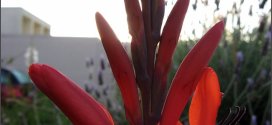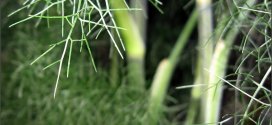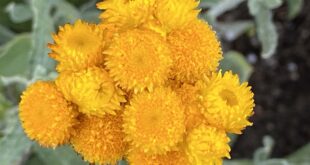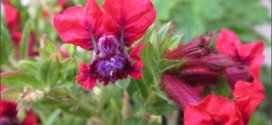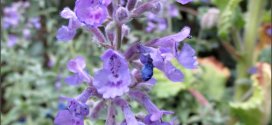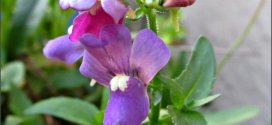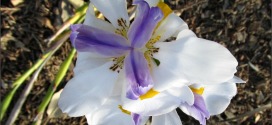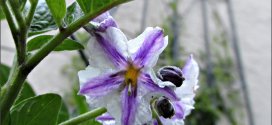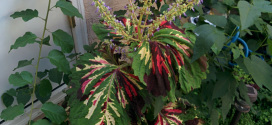Watsonia bulbs are an excellent example of how simple gardening can be when the right plant is matched to suitable growing conditions. Fresh watsonia bulbs are available from early September through mid November only. They naturalize so you can leave them in the soil for next year. Use a large, heavy container; watsonia grow 4-6 feet tall. Fill your containers …
Read More »Tag Archives: perennial
Fennel
If you want to eat the Fennel bulb then make sure you get the Florence Fennel. Fennel is a flowering plant species in the celery family Apiaceae or Umbelliferae. It is the sole species in the genus Foeniculum. It is a hardy, perennial herb with yellow flowers and feathery leaves.
Read More »Helichrysum argyrophyllum
Helichrysum argyrophyllum is a tough and beautiful groundcover. Awesome for spilling over rocks, walls or for edging and containers, the small glistening, almost metallic, ever-silvery leaves and stems of this South African native construct a solid, trailing and ground-hugging mat. And even awesomer, from mid-Summer thru Fall it almost covers itself with showy little canary-yellow “strawflowers” that last for months …
Read More »Cuphea – Flamenco Red
Many gardeners have learned the value of Cuphea for summer long flowers. We value them not only for the small, attractive flowers, but also for the hummingbirds, butterflies, and nectar-feeding insects that swarm around them. Aka Bat-Face Cuphea, St. Peter’s Plant, Tiny Mice, Bunny Ears, Cuphea llavea. Cuphea is a family of plants containing about 115 species according to the …
Read More »Walker’s Low Flower
Walker’s Low Flower, aka Catmint. Catmint is one of the toughest perennials you can grow. It’s a proven performer during hot, dry weather, and the silvery foliage and blue flowers look great most of the season. Deadhead or cut back hard after first flush of bloom to encourage more flowers. Average, well-drained soil is usually sufficient. Tall types may need …
Read More »Linaria purpurea
You can’t get any easier to grow than Linaria purpurea. Slender spikes of tiny violet-blue snapdragon-like flowers over narrow, whorled, blue-grey leaves light up many an old garden. Blooms all Summer in full sun or part shade. Fairly drought tolerant once established & it reseeds! To 3’ high & 1’ wide, it looks good in groupings. Native to southeastern Europe.
Read More »Lily – Fortnight
Attractive, light yellow iris-like flowers with vivid maroon blotches loom on stiff stalks over neat clumps. Fire resistant. Fortnight lily are evergreen perennials with spreading fans of stiff, leathery sword shaped leaves up to 2 ft in length but only 0.75 in wide. Be aggressive in your pruning of them. The upright clumps of leaves are held in a vertical …
Read More »Pepino Dulce
Pepino Dulce produces fruit that are the size of a large goose egg with a cream-colored rind that usually has beautiful purple stripes. I will give you time to look up the size of a goose egg. It has a sweet, mild flesh that is somewhat melon-like. Used fresh in salads or cooked. Beautiful, glossy ornamental plants require a very long …
Read More »Dianthus
The name Dianthus is from the Greek words dios (“god”) and anthos (“flower”), and was cited by the Greek botanist Theophrastus. The color pink may be named after the flower, coming from the frilled edge of the flowers: the verb “pink” dates from the 14th century and means “to decorate with a perforated or punched pattern”. Ecology: Dianthus species are …
Read More »Coleus
Coleus is a pretty foliage plant , Solenostemon scutellarioides Family: Lamiaceae (lay-mee-AY-see-ee) (Info) Genus: Solenostemon (sol-en-oh-STEM-on) (Info) Species: scutellarioides (skew-tell-ar-ee-OH-ih-deez) (Info) Synonym:Coleus blumei Synonym:Coleus scutellarioides Category: Annuals Tropicals and Tender Perennials Height: 12-18 in. (30-45 cm) 18-24 in. (45-60 cm) Spacing: 9-12 in. (22-30 cm) Hardiness: USDA Zone 9a: to -6.6 °C (20 °F) …
Read More »